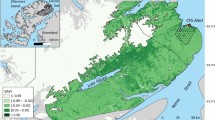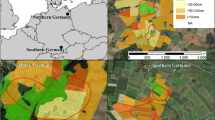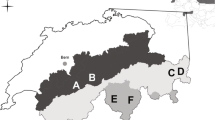Abstract
Mountain hares (Lepus timidus) show high site fidelity even though they are non-territorial and sometimes make long excursions to new areas outside their home range. This study investigates how far apart consecutive annual and seasonal home ranges of the same individual are situated, how much they overlap and if habitat preference can explain the observed high site fidelity. The results show that hares usually overlap their previous home range, both between seasons and years, although the seasonal overlap is smaller, indicating that hares show a more pronounced change of areas between seasons than between years. The seasonal habitat selection was very distinct, tracking changing resource availability between seasons, while the annual selection was difficult to interpret as it mixed the seasonal patterns. Consequently, the annual selection seems to be merely an artefact from the more important seasonal selection. I therefore caution that results from habitat selection studies based on annual home ranges that are estimated from animals in seasonally differing environments should be treated with care. It appears that while seasonal home ranges are selected on the basis of resource availability, there is sufficient variation in the strength of this response to suggest that a mountain hare’s local knowledge of an area could also explain fidelity to their annual home ranges.


Similar content being viewed by others
References
Ahti T, Hämet-Ahti L, Jalas J (1968) Vegetation zones and their sections in northwestern Europe. Ann Bot Fenn 5:169–211
Angerbjörn A, Flux JEC (1995) Lepus timidus. Mamm Species 495:1–11
Ball JP, Danell K, Sunesson P (2000) Response of a herbivore community to increased food quality and quantity: an experiment with nitrogen fertilizer in a boreal forest. J Appl Ecol 37:247–255
Barikmo J, Pedersen HC (1997) Harer og harejakt. Gyldendal Norsk Forlag, Norway (in Norwegian)
Dahl F, Willebrand T (In press) Natal dispersal, adult home ranges and site fidelity of mountain hares Lepus timidus in the boreal forest of Sweden. Wildl Biol
Harris S, Cresswell WJ, Forde PG, Trewhella WJ, Woollard T, Wray S (1990) Home-range analysis using radio-tracking data—a review of problems and techniques particularly as applied to the study of mammals. Mammal Rev 20:97–123
Hjälten J, Danell K, Ericson L (2004) Hare and vole browsing preferences during winter. Acta Theriologica 49:53–62
Hooge PN, Eichenlaub B (2000) Animal movement extension to Arc view ver. 2.0. Alaska Science Centre-Biological Science Office, U.S. Geological Survey, Anchorage, AK, USA
Johnson DH (1980) The comparison of usage and availability measurements for evaluating resource preference. Ecology 61:65–71
Kenward R (1987) Wildlife radio tagging: equipment, field techniques and data analysis. Academic Press, London UK
Kenward RE (2001) A manual for wildlife radio tagging. Academic Press, London UK
Lindlöf B (1978) Agressive dominance rank in relation to feeding by European hare. Viltrevy 10:146–157
Lindlöf B, Lemnell P-A (1981) Differences between island and mainland populations of mountain hare. In: Myers K, MacInnes CD (eds) World Lagomorph Conf. Guelph, Ontario, 1979, pp 478–485
Lindstrom ER, Andren H, Angelstam P, Cederlund G, Hoernfeldt B, Jaederberg L, Lemnell PA, Martinsson B, Skoeld K, Swenson JE (1994) Disease reveals the predator : sarcoptic mange, red fox predation, and prey populations. Ecology 75:1042–1049
Manly BFJ, McDonald LL, Thomas DL, McDonald TL, Erickson WP (2002) Resource selection by animals, statistical design and analysis for field studies. Kluwer Academic Publishers, The Netherlands
Marcström V, Keith LB, Engren E, Cary JR (1989) Demographic responses of arctic hares (Lepus timidus) to experimental reductions of red fox (Vulpes vulpes) and martens (Martes martes). Can J Zool 67:658–668
Morris PA (1988) A study of home range and movements in the hedgehog (Erinaceus europaeus). J Zool 214:433–449
Mysterud A, Østbye E (1999) Cover as a habitat element for temperate ungulates: effects on habitat selection and demography. Wildl Soc B 27:385–394
Pehrson Å (1981) Winter food consumption and digestibility in caged mountain hares. In: Myers K, MacInnes CD (eds) World Lagomorph Conf. Guelph, Ontario, 1979, pp 478–485
Reese H, Nilsson M, Sandström P, Olsson H (2002) Applications using estimates of forest parameters derived from satellite and forest inventory data. Comput Electron Agr 37:37–55
Rühe F, Hohmann U (2004) Seasonal locomotion and home range characteristics of European hares (Lepus europaeus) in an arable region in Central Germany. Eur J Wildl Res 50:101–111
Schoener TW (1981) An empirically based estimate of home range. Theor Popul Biol 20:281–325
Seaman DE, Powell RA (1996) An evaluation of kernel density estimators for home range analysis. Ecology 77:2075–2085
Sievert PR, Keith LB (1985) Survival of snowshoe hares at a geographic range boundary. J Wildl Manage 49:854–866
Smedshaug CA, Selas V, Lund SE, Sonerud GA (1999) The effect of a natural reduction of red fox Vulpes vulpes on small game hunting bags in Norway. Wildl Biol 5:157–166
Swihart RK, Slade NA (1985) Testing for independence of observations in animal movements. Ecology 66:1176–1184
Worton BJ (1989) Kernel methods for estimating the utilisation distribution in home range studies. Ecology 70:164–168
Acknowledgements
This research was funded by the Swedish Hunters Association. I am grateful to Per Sandström for interpretation of satellite images and, Scott Newey, Tuulikki Rooke, Tomas Willebrand and the two anonymous reviewers for helpful comments on the manuscript. This study complies with the current law of Sweden.
Author information
Authors and Affiliations
Corresponding author
Rights and permissions
About this article
Cite this article
Dahl, F. Distinct seasonal habitat selection by annually sedentary mountain hares (Lepus timidus) in the boreal forest of Sweden. Eur J Wildl Res 51, 163–169 (2005). https://doi.org/10.1007/s10344-005-0095-y
Received:
Accepted:
Published:
Issue Date:
DOI: https://doi.org/10.1007/s10344-005-0095-y




